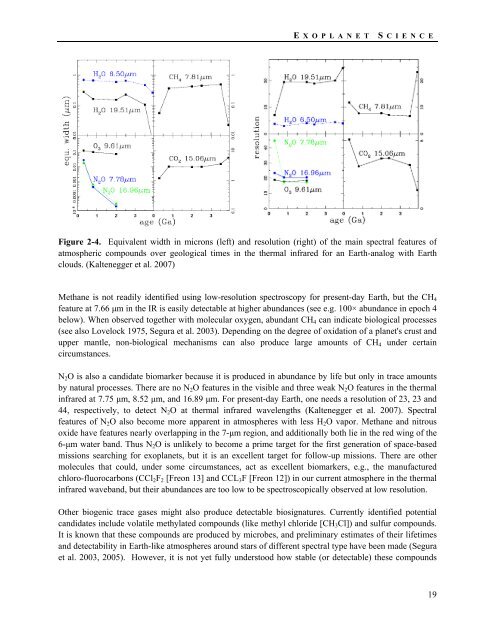TPF-I SWG Report - Exoplanet Exploration Program - NASA
TPF-I SWG Report - Exoplanet Exploration Program - NASA
TPF-I SWG Report - Exoplanet Exploration Program - NASA
You also want an ePaper? Increase the reach of your titles
YUMPU automatically turns print PDFs into web optimized ePapers that Google loves.
E X O P L A N E T S CIENCE<br />
Figure 2-4. Equivalent width in microns (left) and resolution (right) of the main spectral features of<br />
atmospheric compounds over geological times in the thermal infrared for an Earth-analog with Earth<br />
clouds. (Kaltenegger et al. 2007)<br />
Methane is not readily identified using low-resolution spectroscopy for present-day Earth, but the CH 4<br />
feature at 7.66 μm in the IR is easily detectable at higher abundances (see e.g. 100× abundance in epoch 4<br />
below). When observed together with molecular oxygen, abundant CH 4 can indicate biological processes<br />
(see also Lovelock 1975, Segura et al. 2003). Depending on the degree of oxidation of a planet's crust and<br />
upper mantle, non-biological mechanisms can also produce large amounts of CH 4 under certain<br />
circumstances.<br />
N 2 O is also a candidate biomarker because it is produced in abundance by life but only in trace amounts<br />
by natural processes. There are no N 2 O features in the visible and three weak N 2 O features in the thermal<br />
infrared at 7.75 μm, 8.52 μm, and 16.89 μm. For present-day Earth, one needs a resolution of 23, 23 and<br />
44, respectively, to detect N 2 O at thermal infrared wavelengths (Kaltenegger et al. 2007). Spectral<br />
features of N 2 O also become more apparent in atmospheres with less H 2 O vapor. Methane and nitrous<br />
oxide have features nearly overlapping in the 7-μm region, and additionally both lie in the red wing of the<br />
6-μm water band. Thus N 2 O is unlikely to become a prime target for the first generation of space-based<br />
missions searching for exoplanets, but it is an excellent target for follow-up missions. There are other<br />
molecules that could, under some circumstances, act as excellent biomarkers, e.g., the manufactured<br />
chloro-fluorocarbons (CCl 2 F 2 [Freon 13] and CCL 3 F [Freon 12]) in our current atmosphere in the thermal<br />
infrared waveband, but their abundances are too low to be spectroscopically observed at low resolution.<br />
Other biogenic trace gases might also produce detectable biosignatures. Currently identified potential<br />
candidates include volatile methylated compounds (like methyl chloride [CH 3 Cl]) and sulfur compounds.<br />
It is known that these compounds are produced by microbes, and preliminary estimates of their lifetimes<br />
and detectability in Earth-like atmospheres around stars of different spectral type have been made (Segura<br />
et al. 2003, 2005). However, it is not yet fully understood how stable (or detectable) these compounds<br />
19
















